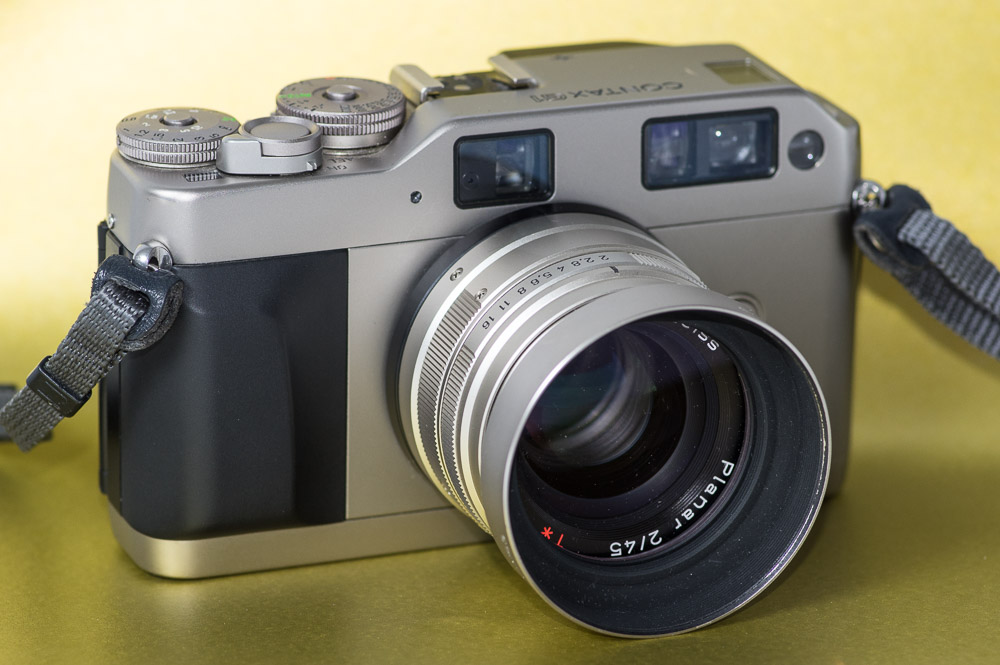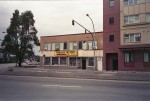Nov
20
2015

In my previous post Contax G1 I talked about this camera and its features and operation. I can sum that up in two words ‘flawed beauty’. Although a fantastic camera by many measures there were a few issues that bothered me particularly the focusing and the small viewfinder. If I’m going to use a rangefinder I much prefer a larger viewfinder, that said the technical reasons for the small viewfinder (being able to adjust to different focal lengths) are understandable, it is more complex in itself than many entire cameras. 
All this is forgiven when you factor in the lenses such as the 45mm f2 (6 elements in 4 groups) which is just incredible. The camera is a technological tour de force but perhaps trying to be all things at once it detracts from the essence of photography. Don’t get me wrong maybe what is needed is more time shooting with it but it comes across for me as a very large point and shoot with fantastic lenses. An incredibly well made beautiful feature rich really big point and shoot…..okay there was nothing else like this camera at the time and maybe it shouldn’t be compared to anything.
no comments | tags: Contax, Ektar, film camera, Kodak | posted in Cameras, Photography
Nov
16
2015
 This camera is interesting for several reasons, the primary one being that although it is a point and shoot with a fixed lens the zoom is controlled by twisting the front of the lens instead of some small button or lever like most other point and shoots.
This camera is interesting for several reasons, the primary one being that although it is a point and shoot with a fixed lens the zoom is controlled by twisting the front of the lens instead of some small button or lever like most other point and shoots. 
This allows for very fast zooming with the focal length indicated in a window on the top plate. Unfortunately the lens has very bad chromatic aberrations which appear as coloured fringing around objects particularly towards the edges of the image.

Additionally my copy of this camera has obvious dust and fibers inside the lens somewhere that show up in some of the images as well as a hazy blue spot sometimes in the center. 
None of this is outwardly visible on the lens. So the only thing this camera is good for is if you are trying to take pictures that look like they came from a terrible camera. This is despite the fact that the lens is branded as Vivitars top of the line ‘Series 1’ with 8 elements in 7 groups.
no comments | tags: film, film camera, vivitar | posted in Cameras, Photography
Jul
26
2015

I was kindly lent a Contax G1 and three lenses and took the opportunity to shoot four rolls of film with it. The first thing you notice on picking it up is that it is an absolute gem. The level of finish is exceptional it feels like it was milled out of a solid block of titanium. It does have a nice rubberized grip but is a little too heavy to easily use one-handed. The autofocus works well as long as you ensure that you set the center focus point on the subject. That’s fine for individual portraits but it caught me out a couple of times when it focused between two people despite my efforts. Additionally the focus is the loudest aspect of the camera drowning out the shutter and film advance although not really achieving objectionable levels. It’s too bad because even using manual focus doesn’t mitigate the noise as it works by ‘fly by wire’ and focuses to the distance you set on the top dial. Strangely when you change to manual focus rather than providing you an indication of the actual distance in the viewfinder as it does with autofocus it just gives an uncalibrated indication of whether you are setting focus in front or behind what the autofocus has determined. That and the fact that the manual focus dial is easily knocked inadvertently I would suggest that leaving it in AF mode is the order of the day. Moving on to the viewfinder there is good news and bad news. The good news is that it adjusts it’s field of view depending on the lens that is mounted. To achieve this though it would seem that it was necessary to engineer it much like the viewfinder you would see on a zoom point and shoot and the result is that it is a small viewfinder that is sometimes hard to bring quickly to the eye, like is possible with a fixed lens rangefinder, that’s the bad. Additionally on the good side of things the viewfinder automatically changes its masking to adjust for parallax and focus.
Okay that’s all well and good, it’s a beautiful piece of camera engineering but what about the lenses? Well if the camera is a gem the lenses are diamonds. The standard lens the Zeiss T* Planar 2/45 is perfectly matched and exquisitely built. With the camera I was also lent the 28mm f2 Biogon and 90mm f2 Sonnar two lenses equally as beautiful. The legendary Zeiss T* coating is evident on all the lenses. In the center of the lens barrel is the aperture ring with a nice solid detent for each setting. Because the manual focus is done at the body there are no other external moving parts to the lens. The lenses are as good optically as they are aesthetically pleasing. The rendering of out of focus areas (bokeh) is terrific giving the images a strong three dimensionality. Unfortunately the limited number of aperture blades shows in the background highlights as hexagonal shapes rather than nicely rounded as is possible with more or curved blades. All three lenses have exceptional sharpness from corner to corner they may very well be the best film camera lenses I’ve ever used.
A few other features of the camera are its top shutter speed of 1/2000 of a second it has +-2 EV exposure compensation and will do three frame bracketing. You do have to be careful if you override the DX reading system to set a manual ISO as it does not revert back, it can be very easy to accidentally leave it at an incorrect setting (Something to remember) Also it’s not impossible to forget to remove the lens cap although you will get a very wrong exposure as the metering is TTL which is another amazing piece of engineering. It actually uses the light reflected off the shutter curtain to determine exposure.
One thing about one camera: It was the first ever autofocus rangefinder camera
Here are some of my first sample images there are more to come after I develop more film
no comments | tags: Contax, film camera | posted in Cameras, Photography, Uncategorized
Mar
27
2015

Also know as the Ricoh Shotmaster 130 Super
I’ve written about this camera previously but there are a few unique details that I haven’t mentioned.
The auto backlight control is coupled to the focus system, if a backlit subject is greater than 20 feet away it will adjust the exposure alone but if the subject is closer it will use fill flash, nice and automatic.
In Super Night Shot mode if you are taking a portrait the camera will first focus to infinity and take an exposure for up to 2 seconds it then closes the shutter refocuses on the subject and takes a second exposure with flash, if there is no subject within 6m then the camera just takes the long exposure without the second flash image.
The RZ3000 can adjust exposure for light levels in the range of 3.5EV to 17EV. (EV 3.5 with ISO 400 film would be something like candle light or a night scene with lights)
Originally listed at around $300 in 1996 the RZ3000 can now be had for less than the cost of a roll of film, although this fate is not unique to it. If it wasn’t for the complete depreciation of these cameras I couldn’t hope to have this much fun.
no comments | tags: film camera, Ricoh | posted in Cameras, Photography
Feb
26
2015

The Leica Mini cost about $300 when it was new while the Minolta Freedom Escort cost about $85 I’ve written previously about how these are for all intents and purposes the same camera. Fraternal twins? Leica and Minolta
Despite this knowledge the gravitational pull of the Leica still seems to draw me in as it obviously has others. It’s true Leica have created some incredible photographic equipment and I guess this halo allowed them to charge more for the same thing such as the Leica Digilux 4.3 which was essentially a Fujifilm 4700 or the Leica Digilux 3 which was the same as a Panasonic Lumix DMC-L1 and there were and are more examples. There is always just enough modification to at least create the plausibility of justification whether it’s the lens or firmware. In the case of the Leica Mini its the lens that is different but from what I can see there is little or no gain over the Minolta. See what I just did there? Even I hedged my bet that there could be a difference, what am I afraid of, the not so secret society the Leicati? If having a Leica is something that matters to you then this is a good one to have it’s cheap and decent and has a red dot but if you can’t find one you could always just put a red dot on the Minolta.

no comments | tags: film camera, Leica | posted in Cameras, Photography
Jan
28
2015

This is the second part of the image gallery from my Braun Super Paxette. The first part can be seen here August 2014 Braun Super Paxette
In the interm I’ve picked up another Super Paxette because I like this one so much. The shutter may need a little cleaning but having a backup to this camera is worth it.
1 comment | tags: braun, film camera, Paxette | posted in Cameras, Photography





















































































































